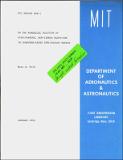On the numerical solution of simultaneous, non-linear equations in computer-aided preliminary design
Author(s)
Kolb, Mark A.
DownloadFTL_R_1986_01.pdf (5.637Mb)
Other Contributors
Massachusetts Institute of Technology. Flight Transportation Laboratory
Metadata
Show full item recordAbstract
In the solution of problems in preliminary design, it often becomes necessary to solve systems of equations. An immediate example from aeronautical design is the frequent need to perform several iterations around the gross takeoff weight in order to determine a consistent value for this design variable. The Paper Airplane program is the result of research by the MIT Flight Transportation Laboratory into automating the computational aspects of preliminary design, with the object of freeing the designer to concentrate on the more creative aspects of the design process. Paper Airplane is written in Common LISP (augmented by the object-oriented programming "f lavor" construct, supported by NIL and ZetaLisp), and implemented on both a VAX-11/750 and a Texas Instruments EXPLORER Lisp Machine. In its original form, Paper Airplane possessed the capability of transforming declarative knowledge about design relationships into imperative form; i.e., the declarative statement, w = fi(X, y, z), could be understood to imply that z = f 2(w, y, z), y = fs(w, z, z), and z = f 4 (w, z, y), as well. Understanding of this concept was simulated by applying the Newton-Raphson method to numerically invert design relationships. This capability enabled Paper Airplane to solve design problems which could be reduced to sets of single, independent equations. However, no techniques were available for cases in which iteration was required to solve the design relationships-i.e., when the system could only be reduced to two or more simultaneous equations. Towards the end of providing this additional capability, three numerical techniques for solving sets of two equations in two unknowns were examined. In the course of investigating these approaches, the need for explicit representation of the steps by which design relationships were to be used to calculate values for design variables was recognized, and appropriate software representations were developed. The first of these techniques, the so-called "fixed-point" method, involves assuming a value for one variable, based upon which the equations are solved, enabling calculation of a new value for the variable whose value was assumed. This calculated value is used as the assumed value for the next iteration, repeating this 3rocess until, if possible, the value calculated at the end of an iteration is sufficiently close to the value assumed at the beginning of the iteration. In the "simultaneous Newton-Raphson" method, a value is again assumed for one variable, and design relationships are chained together in such a way as to make it possible to calculate two values for a second variable. The assumed value is updated by calculating the intersection of tangent lines determined by the derivatives of the two chains of design relationships, until the values calculated by both chains are identical. Upon establishing that the two former methods rely upon invalid assumptions concerning the linearity of design relationships, a third method, the "logarithmic distribution" method was examined. In setting up the problem, an approach parallel to that used in the "simultaneous Newton-Raphson" method is taken, but the solution to the system of equations is determined by testing logarithmically distributed values over progressively smaller search intervals. Due to difficulties associated with design relationships which are multi-valued in certain directions, this technique required modification to the procedure whereby design relationships are numerically inverted, using the Newton-Raphson method. It was found that by making the selection of the initial guess value for the Newton-Raphson procedure stochastic, multi-valued relationships could be prompted to use the appropriate branches, when necessary. To more effectively deal with multi-valued branches, application of symbolic algebra techniques and further modifications to the Newton-Raphson procedure are proposed.
Description
January 1986"--Cover Also issued as an M.S. thesis, Massachusetts Institute of Technology, Dept. of Aeronautics and Astronautics, 1986 Includes bibliographical references (p. 89-91)
Date issued
c1986Publisher
Cambridge, Mass. : MIT, Dept. of Aeronautics & Astronautics, Flight Transportation Laboratory, c1986
Other identifiers
16386527
Series/Report no.
FTL report (Massachusetts Institute of Technology. Flight Transportation Laboratory) ; R86-1
Keywords
Aeronautics, Nonlinear integral equations, Design and construction, Numerical solutions